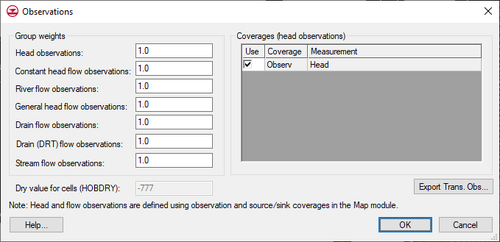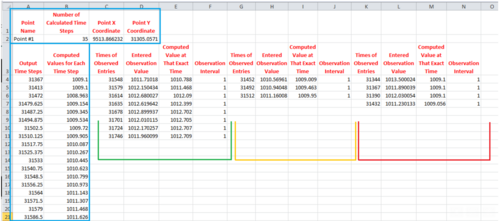GMS:Observations: Difference between revisions
From XMS Wiki
Jump to navigationJump to search
| (10 intermediate revisions by 2 users not shown) | |||
| Line 12: | Line 12: | ||
==Observation Weights== | ==Observation Weights== | ||
When performing [[GMS:Automated Parameter Estimation|automated parameter estimation]], a set of head and flow observations are defined using points, arcs, and polygons in the Map module. When entering the point and flow observations, care should be taken when entering the calibration interval and confidence values. These values are used to determine the weights assigned to each observation in the inverse model. The weight is multiplied by the residual for the observation in the objective function. The weight that is sent to the inverse model input files by GMS is computed as | When performing [[GMS:Automated Parameter Estimation|automated parameter estimation]], a set of head and flow observations are defined using points, arcs, and polygons in the Map module. When entering the point and flow observations, care should be taken when entering the calibration interval and confidence values. These values are used to determine the weights assigned to each observation in the inverse model. The weight is multiplied by the residual for the observation in the objective function. The weight that is sent to the inverse model input files by GMS is computed as: | ||
:<math>\sqrt{\frac{1}{ \big( \text{Standard Deviation} \big) ^2 * \text{Group Weight} }}</math> | |||
:[[Image:observeq1.jpg]] | <!--:[[Image:observeq1.jpg]]--> | ||
Note that GMS will automatically convert from an interval and a confidence to a standard deviation, or directly enter the standard deviation. | Note that GMS will automatically convert from an interval and a confidence to a standard deviation, or directly enter the standard deviation. | ||
| Line 31: | Line 31: | ||
#''Stream flow observations'' | #''Stream flow observations'' | ||
Options 2& | Options 2–6 correspond to flow observations that are defined using the ''Observed flow rate'' option. | ||
The default value for the group weights is 1.0. The default value can be changed to give a larger influence to a particular observation type. For example, if a particular model had sixteen head observations and one flux observation corresponding to a stream gage, a better solution may be obtained by increasing the flux group weight to give more weight to the stream gage measurement. | The default value for the group weights is 1.0. The default value can be changed to give a larger influence to a particular observation type. For example, if a particular model had sixteen head observations and one flux observation corresponding to a stream gage, a better solution may be obtained by increasing the flux group weight to give more weight to the stream gage measurement. | ||
| Line 50: | Line 50: | ||
===Export Trans. Obs.=== | ===Export Trans. Obs.=== | ||
Beginning with version 8.0, this button allows exporting a *.csv (comma separated values) file with transient observation data. This file can be loaded into excel to create plots of the transient observation values vs. the model computed values. | [[File:obs_data_csv.png|thumb|500px|The exported CSV file. The columns are divided by calibration targets (e.g. the green column corelates with green calibration targets).]] | ||
Beginning with version 8.0, this button allows exporting a *.csv (comma separated values) file with transient observation data. This file can be loaded into excel to create plots of the transient observation values vs. the model computed values. | |||
The outputs consist of three main parts: | |||
* The header, which signals the start of a new section. This contains the point name, the point's xy coordinates, and the number of calculated time steps that are printed for it. | |||
* The calculated values, which contains one column with the list of time steps (as determined by the MODFLOW Output Control settings), and one column with the Computed values for each of those times. | |||
* The observed values, which is a section that contains several groupings. Each one has a list of times for which an observation was entered, the entered observation value for that time, and the computed value at that exact time. (This is sometimes different than the output times from the calculated list, so it provides an exact value to compare, instead of requiring an estimation based on the output list.) | |||
==Confidence Interval and Standard Deviation== | ==Confidence Interval and Standard Deviation== | ||


